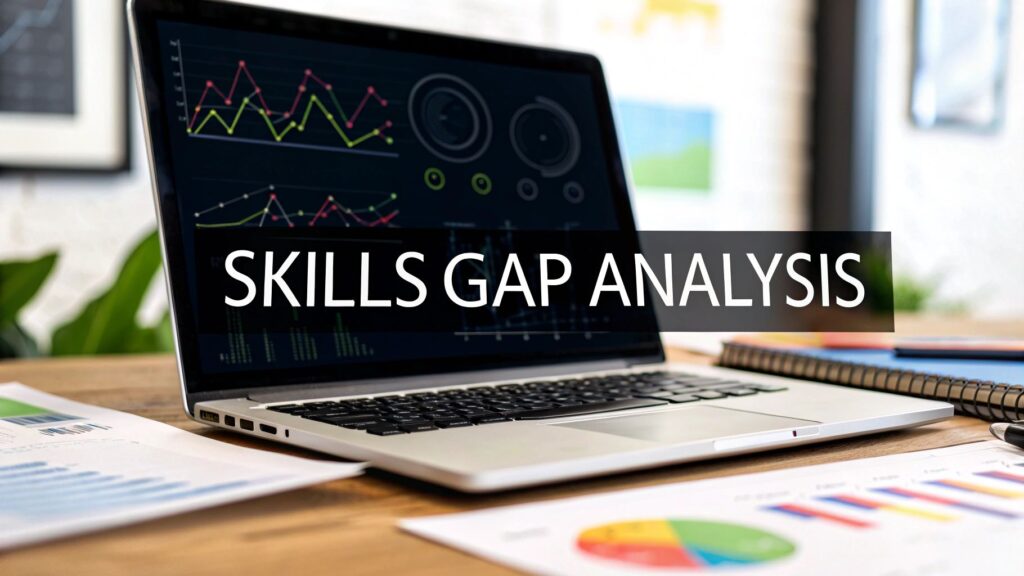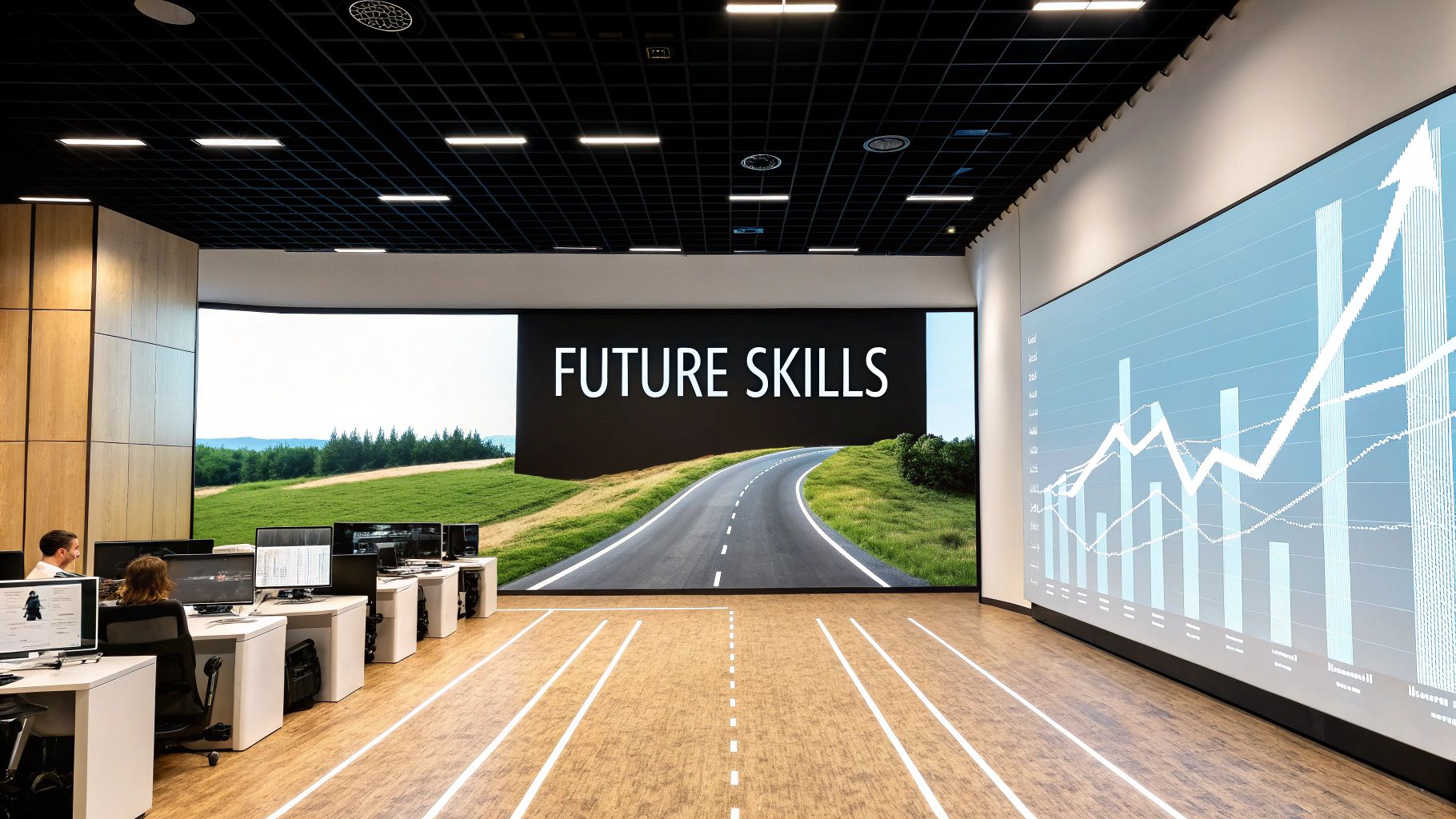
Skills Gap Analysis: Boost Workforce Performance
The Growing Skills Gap Crisis: What's Really at Stake

The modern workforce in the AE region faces a significant hurdle: the ever-widening skills gap. This isn't simply a concern for HR departments; it's a critical business challenge affecting organizations across all sectors. Rapid economic transformations, especially the shift toward new business models and digital advancements, have revealed a significant disparity between the skills currently available and those required for future success. This mismatch has tangible and far-reaching consequences.
Many regional executives and HR leaders are reporting substantial project delays due to talent shortages. Recruitment costs are also escalating as companies compete for a limited pool of qualified individuals. This intensified competition disproportionately affects smaller businesses, which often lack the financial resources to match the compensation packages offered by larger corporations. This situation ultimately stifles growth and innovation throughout the region, potentially jeopardizing long-term economic prosperity.
The Middle East and North Africa (MENA) region is also wrestling with a substantial skills gap that poses a threat to economic advancement and innovation. Countries like the UAE, Saudi Arabia, and Egypt have undergone rapid economic diversification, moving away from traditional industries like oil and gas and toward sectors like technology and healthcare. However, the demand for skilled professionals in these burgeoning fields significantly surpasses the available supply.
For example, Saudi Arabia's Vision 2030 aims to expand the technology sector, yet the region currently lacks a sufficient number of skilled tech workers. This deficit is often attributed to a disconnect between educational systems and the actual needs of industries. Traditional curricula frequently prioritize theoretical knowledge over practical skills training. Consequently, businesses struggle to find suitably qualified talent, resulting in project execution delays and higher operating costs due to a reliance on expatriate workers or outsourcing. For a more detailed analysis, explore these statistics: Skills Gap in the MENA Workplace
The Consequences of Inaction
Failing to address the skills gap is a dangerous path. Organizations that neglect these talent deficiencies will likely encounter a range of negative repercussions:
-
Loss of Competitiveness: Without the right skills, companies will struggle to innovate and adapt to evolving market dynamics.
-
Decreased Productivity: Employees who lack essential skills are often less efficient and productive, negatively impacting overall organizational performance.
-
Increased Employee Turnover: When employees feel frustrated by a lack of adequate training and development opportunities, they may seek better prospects elsewhere.
-
Reputational Damage: An organization’s reputation can suffer if it fails to meet customer expectations due to skill deficiencies within its workforce.
These consequences highlight the urgent need for organizations in the AE region to prioritize skills gap analysis. Traditional talent acquisition methods are no longer sufficient. Organizations need to proactively identify their skills gaps and implement strategies to bridge them. This ensures they have the workforce needed to succeed in today's dynamic environment. This proactive approach to workforce planning is not only vital for individual businesses but is also essential for the sustainable economic growth of the entire AE region.
Building Your Skills Gap Analysis Framework That Works

A simple competency mapping exercise isn't enough to maximize workforce potential. A robust skills gap analysis framework is essential. This goes beyond simply listing skills. It requires understanding your organization's current and future needs. This section explores how successful organizations in the Arab Emirates (AE) region are achieving this.
Aligning Competency Frameworks With Business Objectives
A well-defined competency framework is the foundation of effective skills gap analysis. However, many organizations base these frameworks on abstract ideals instead of concrete business objectives. For example, "communication skills" is too broad. Instead, define specific needs, such as "presenting technical information to non-technical audiences." This focused approach ensures the framework aligns with your business goals. Consider the AE region's unique cultural dynamics to ensure relevance.
This table compares traditional skills gap analysis methods with a more modern, MENA-focused approach:
Skills Gap Analysis Components Comparison
| Component | Traditional Approach | Modern MENA-Focused Approach | Regional Considerations |
|---|---|---|---|
| Focus | Primarily on technical skills | Broader focus, including soft skills and cultural competencies | Emphasis on intercultural communication, adaptability, and regional specific technical skills |
| Data Collection | Surveys, interviews, and performance reviews | 360-degree feedback, skills assessments, and data analytics platforms | Consideration of language barriers and cultural sensitivities in data collection methods |
| Analysis | Basic comparison of required vs. existing skills | Advanced analytics to identify hidden skills gaps and predict future needs | Analysis of regional market trends and talent availability |
| Action Planning | Generic training programs | Personalized development plans and targeted recruitment strategies | Leveraging regional training resources and partnerships |
The key takeaway from this comparison is the importance of a tailored approach for MENA organizations. Modern methods prioritize a broader range of skills, utilize sophisticated data analysis techniques, and incorporate regional considerations to ensure the effectiveness of the skills gap analysis process.
Practical Approaches to Skills Inventory Development
Developing a skills inventory is crucial. It should capture technical and soft skills. Problem-solving, adaptability, and intercultural communication are vital in the AE's diverse business landscape. Practical approaches include self-assessments, manager evaluations, 360-degree feedback, and skills-based testing. Combining these methods provides a comprehensive view of workforce capabilities.
Building an Actionable Skills Gap Analysis Process
The goal of a skills gap analysis is to generate actionable insights. This requires a structured process that goes beyond simply identifying gaps.
-
Prioritize Gaps: Focus on gaps impacting business objectives.
-
Develop Strategies: Implement training, mentorship, or recruitment to address gaps.
-
Measure Results: Track the effectiveness of initiatives using performance evaluations and other metrics.
A well-structured skills gap analysis process allows AE organizations to turn challenges into growth opportunities. This builds a skilled and adaptable workforce. This benefits individual organizations and contributes to the region's economic competitiveness.
Industry-Specific Skills Gaps: What the Data Reveals

Moving beyond general discussions, let's explore the specific skills shortages affecting key industries across the AE region. A thorough skills gap analysis reveals distinct challenges and opportunities within each sector. This detailed understanding allows organizations to strategically invest in workforce development for maximum impact.
Sector-Specific Challenges and Opportunities
Different industries experience unique skills gaps. For instance, the rapidly growing tech sector in the UAE often struggles to find qualified cybersecurity specialists and AI developers. The healthcare industry, meanwhile, faces a shortage of specialized nurses and medical technicians. Even well-established sectors like oil and gas require evolving skillsets in areas like digitalization and sustainability. These sector-specific demands emphasize the need for focused skills gap analyses.
A one-size-fits-all approach simply won't work. Each sector needs its own framework for conducting a skills gap analysis. This framework should account for the specific technical skills, soft skills, and emerging trends shaping the industry. This precision allows for more targeted training and development initiatives. For example, the National Academy, working with established institutions, provides technical, language, and soft skills courses specifically designed for the UAE market.
Public vs. Private Sector Discrepancies
Clear differences exist between skills gaps in the public and private sectors. Public sector organizations often struggle to attract and retain employees with strong digital skills. This digital skills gap can negatively impact areas such as e-government services and data analysis. The private sector, while also undergoing digital transformation, often faces more immediate pressure to adapt to changing market demands.
This means private sector organizations may prioritize skills in areas like customer relationship management (CRM) and innovative product development. In the Gulf Cooperation Council (GCC) countries, the skills gap is particularly pronounced in vital sectors such as oil and gas, construction, finance, healthcare, and tourism. Only about 35% of public sector employees possess the necessary skills for their current roles, demonstrating a clear need for upskilling initiatives.
Around 61% of Middle Eastern workers anticipate significant job changes in the next five years, requiring new skills and abilities. The GCC also faces shortages in specialized areas, including digital skills within the oil and gas sector, data analytics in finance, and healthcare IT. The construction sector needs more project managers and professionals with expertise in sustainable building practices. Governments are investing in education and working with private companies to create targeted training programs to address these gaps. Learn more about the regional skills gap here.
The Importance of Targeted Investments
Understanding these industry-specific skills gaps empowers informed investment decisions. Businesses can direct training budgets toward areas with the largest shortages. This focused approach maximizes resource allocation and ensures that investments deliver the greatest return. For instance, a construction firm struggling to find qualified project managers might choose to invest in project management certification programs for their current staff. This not only addresses a critical skills gap but also encourages internal career growth. By understanding the specific needs of each industry, organizations can tailor workforce development strategies and build a workforce prepared for future success.
Implementing Skills Gap Analysis: Your Step-by-Step Guide

Turning an understanding of skills gaps into actionable steps requires a well-defined strategy. This section provides a step-by-step guide to implementing a skills gap analysis and generating real value for your business. Whether your organization is large or small, this guide offers practical techniques, with a specific focus on the AE region.
Phase 1: Planning and Stakeholder Alignment
A successful skills gap analysis starts with careful planning. This involves defining the scope. Will you analyze a specific department, a certain role, or the entire organization? Defining this scope focuses efforts and ensures the analysis aligns with your overarching business goals.
Getting key stakeholders on board is also essential. This includes department heads, HR professionals, and employees. Clearly communicating the purpose and advantages of the analysis encourages participation and establishes shared goals. This collaborative approach is particularly vital in the AE region, which emphasizes strong relationships and transparent communication.
Phase 2: Data Collection and Assessment
With a plan in place, the next step is data collection. There are several ways to assess current skills:
-
Self-Assessments: Employees evaluate their own skills.
-
Manager Evaluations: Supervisors assess their team members’ abilities.
-
360-Degree Feedback: Input from peers and subordinates provides a well-rounded perspective.
-
Skills-Based Testing: Objective tests offer quantifiable data on skill proficiencies.
Selecting the right combination of these methods ensures a complete understanding of your workforce's current capabilities. Consider regional nuances in the AE region. Make sure assessment tools are available in local languages and account for cultural differences in self-assessment.
Phase 3: Gap Identification and Prioritization
After gathering data, you can identify gaps between current and required skills. This involves comparing your collected data with your established competency framework. This comparison reveals skill deficiencies.
It's important to remember that not all skills gaps have the same impact. Prioritize gaps that directly affect essential business objectives or impede critical projects. This ensures resources are allocated effectively.
Phase 4: Action Planning and Implementation
Identifying skills gaps is just the beginning. The real benefit comes from creating and implementing action plans to address those gaps. Here are several options:
-
Internal Training Programs: Organizations like the National Academy offer various technical, language, and soft skills courses designed for the AE market. These programs can effectively upskill your workforce.
-
External Partnerships: Partnering with universities or specialized training providers gives you access to external expertise.
-
Targeted Recruitment: Sometimes, hiring new employees with the required skills is necessary.
Create a clear roadmap with defined timelines and measurable objectives. This roadmap should align with your broader business strategy and incorporate regional factors, such as nationalization targets in the AE area.
Phase 5: Monitoring and Evaluation
The final phase involves monitoring and evaluating the impact of your initiatives. This includes tracking employee progress, collecting feedback, and assessing the effect on key performance indicators (KPIs). Consistent monitoring enables adjustments and ensures strategies deliver the desired results.
This ongoing process maximizes your return on investment in skills development and keeps your workforce ready to meet the evolving demands of the AE business landscape. This systematic approach transforms skills gap analysis from a one-time activity into a continuous process of workforce optimization.
To illustrate the timeline and process, consider the following table:
Skills Gap Analysis Implementation Timeline: A detailed breakdown of the skills gap analysis process with estimated timeframes for each phase
| Phase | Key Activities | Stakeholders Involved | Typical Duration | Regional Considerations |
|---|---|---|---|---|
| Planning & Alignment | Define scope, secure stakeholder buy-in, set objectives | Senior Management, HR, Department Heads | 2-4 weeks | Cultural sensitivity in communication and objectives |
| Data Collection & Assessment | Conduct surveys, interviews, assessments, analyze performance data | Employees, Managers, HR | 4-8 weeks | Language availability of assessments, cultural norms in self-reporting |
| Gap Identification & Prioritization | Compare current skills with required competencies, prioritize gaps based on business impact | HR, Department Heads, Subject Matter Experts | 2-4 weeks | Alignment with nationalization targets |
| Action Planning & Implementation | Develop training programs, implement learning initiatives, track progress | HR, L&D, Employees, External Partners | Ongoing | Leveraging local training providers, considering regional certification requirements |
| Monitoring & Evaluation | Measure impact on KPIs, gather feedback, adjust strategies | HR, Department Heads, Senior Management | Ongoing | Cultural nuances in feedback collection |
This table provides a general framework. Specific timelines and activities may vary based on organizational context and resources. Regular review and adaptation are key to a successful and sustained skills gap analysis process.
Digital Transformation: The Skills Evolution Imperative
Digital transformation is significantly changing how businesses in the AE region and globally operate. It's impacting not only operational processes, but also the required workforce skill sets. This shift presents both challenges and opportunities for organizations as they adapt their workforce strategies. By examining the perspectives of leaders involved in digital transformation, we can gain insights into this evolving skills landscape and its impact on the future of work.
The Rise of New Competencies
Technologies like AI, cloud computing, and data analytics are highly sought after. This demand has created an unprecedented need for individuals with new skills and competencies. Expertise in programming languages such as Python and R, along with proficiency in cloud platforms like AWS and Microsoft Azure, are becoming increasingly vital across diverse industries. These digital capabilities aren't solely technical; they also include critical thinking, problem-solving, and adaptability in response to ongoing technological advancements.
Organizations must identify the digital skills that offer the highest return on investment (ROI). Prioritizing these in-demand skills enables companies to focus their training and recruitment efforts effectively. Furthermore, soft skills such as communication and collaboration remain crucial, even in highly technical positions. These soft skills empower individuals to use their technical expertise effectively, driving innovation and achieving business goals.
Anticipating Future Skills Requirements
A key challenge of digital transformation is the rapid pace of technological change. Skills in high demand today might be obsolete tomorrow. Organizations must take a proactive approach to skills gap analysis. This involves identifying emerging technologies and predicting their influence on future job roles.
This forward-thinking approach is essential for developing effective workforce strategies. By understanding future skill requirements, organizations can invest in training programs and recruitment initiatives that equip their employees for upcoming changes. This proactive strategy is especially important in the rapidly evolving digital landscape of the AE region, where technology adoption is often swift and widespread.
Navigating the Digital Skills Revolution
Digital transformation is a significant factor driving the skills gap in the MENA region. As digitalization disrupts traditional roles and displaces jobs, the demand for specialized digital skills continues to grow. An estimated 152 million jobs worldwide will be displaced in the next five years because of digital transformation. In the MENA region, only about 1.7% of the workforce is currently classified as digital talent, highlighting a significant shortage in this area. Discover more insights about the regional skills gap. Countries are responding by launching digital skills training initiatives. For instance, governments are partnering with platforms like LinkedIn to analyze labor markets and pinpoint required skills, such as programming languages like JavaScript and data science expertise in technologies like Microsoft Azure. Despite these efforts, challenges remain, including retaining tech talent, as many professionals seek opportunities abroad.
Leading organizations are proactively addressing this digital skills revolution. They are investing in comprehensive training programs, collaborating with educational institutions to develop customized curricula, and building internal talent pipelines to cultivate future leaders. They are also implementing innovative recruitment strategies to attract and retain top digital talent. These strategies include offering competitive salaries and benefits packages, along with fostering a culture of continuous learning and development. By employing these tactics, organizations are building a workforce equipped to thrive in the dynamic digital landscape. They are also contributing to the sustainable economic growth of the AE region by developing a highly skilled and adaptable workforce.
Bridging the Gap: Strategies That Deliver Real Results
Identifying skills gaps is only the first step. The real challenge lies in effectively closing them and transforming assessments into tangible workforce improvements. This requires a strategic approach that goes beyond simply offering training programs. It demands a fundamental shift in how organizations view talent development.
Building Effective Upskilling Programs
Many upskilling initiatives fall short because they lack a clear connection to business objectives. Successful programs begin with a thorough understanding of the specific skills needed to achieve strategic goals. For example, if a company is expanding into e-commerce, training programs should focus on digital marketing, data analytics, and customer relationship management.
Effective programs incorporate a variety of learning methods. These can include:
- Online courses
- Workshops
- On-the-job training
- Mentorship
This blended approach caters to different learning styles and ensures that employees gain practical experience alongside theoretical knowledge. Consider partnering with local institutions, like the National Academy, which offer specialized training tailored for the AE market.
Leveraging Internal Development and External Partnerships
Closing skills gaps often requires a combination of internal development and external partnerships. Internal development initiatives, such as mentorship programs and cross-functional projects, allow employees to learn from experienced colleagues and gain exposure to different areas of the business.
However, some specialized skills may be best acquired through external partnerships with universities, training providers, or industry experts. This blended approach allows organizations to leverage external expertise while also fostering internal talent development.
For example, a company could partner with a university to develop a customized training program in a specific technical area. Simultaneously, they could establish a mentorship program to help employees apply their new knowledge on the job.
Targeted Recruitment: Filling Critical Gaps
While upskilling and reskilling are crucial, sometimes the fastest and most effective way to address a critical skills gap is through targeted recruitment. This involves actively seeking out individuals with the specific skills needed to fill immediate vacancies or support strategic growth initiatives.
However, recruitment should not be seen as a replacement for internal development. A balanced approach combines strategic hiring with ongoing efforts to upskill the existing workforce. This ensures that the organization has both the immediate skills needed to compete and a pipeline of talent ready to meet future challenges. As businesses undergo digital transformation, HR departments must adapt. Read about strategies for real impact in HR Digital Transformation.
Building a Skills Development Roadmap
Creating a comprehensive skills development roadmap is essential for long-term success. This roadmap should align with both nationalization agendas—such as the UAE's Emiratization program—and immediate business imperatives. It should outline specific goals, timelines, and resources needed to develop critical skills within the workforce. Regularly reviewing and updating this roadmap is crucial to ensure it remains relevant in a changing business environment.
Measuring the Impact of Talent Initiatives
Finally, it's essential to measure the impact of talent initiatives. This involves tracking key performance indicators (KPIs) such as:
- Employee productivity
- Project completion rates
- Customer satisfaction
By analyzing this data, organizations can determine the effectiveness of their skills development programs and make adjustments as needed. This data-driven approach ensures that investments in talent development generate measurable performance improvements. A well-designed evaluation framework provides insights into which initiatives are working, which need refinement, and which should be discontinued. This continuous improvement cycle is key to building a workforce that is both highly skilled and adaptable to the changing demands of the AE region's dynamic business landscape.
Ready to bridge your organization's skills gap and unlock workforce potential? Explore the tailored training solutions offered by the National Academy. Visit https://naisedu.com to learn more about their comprehensive courses and personalized development plans.